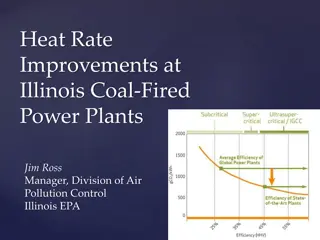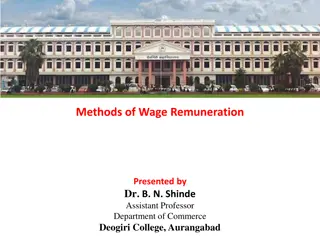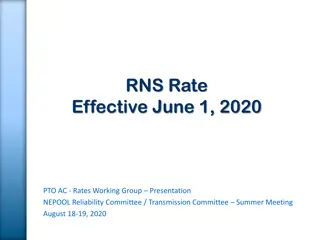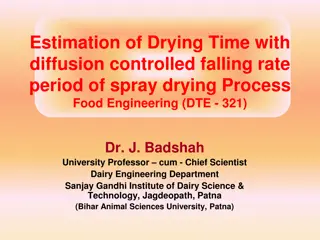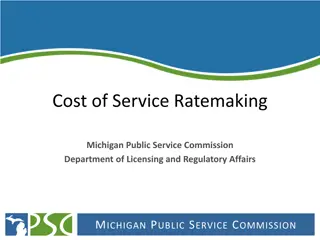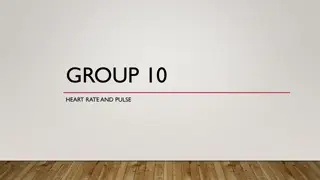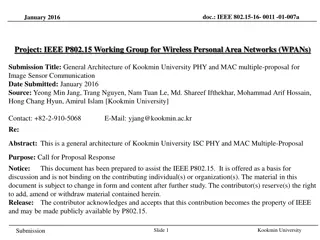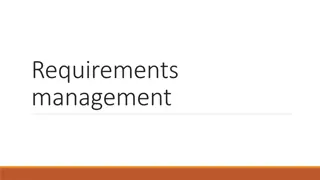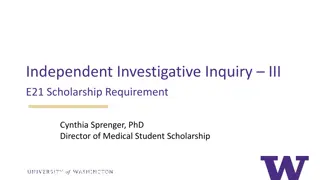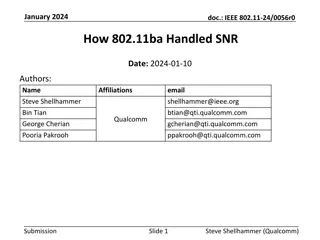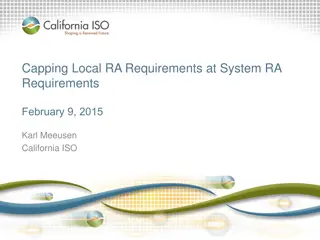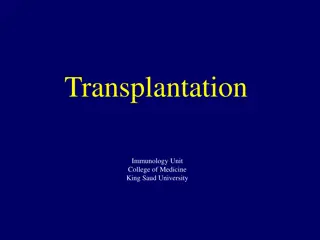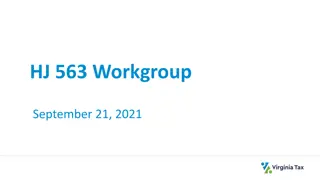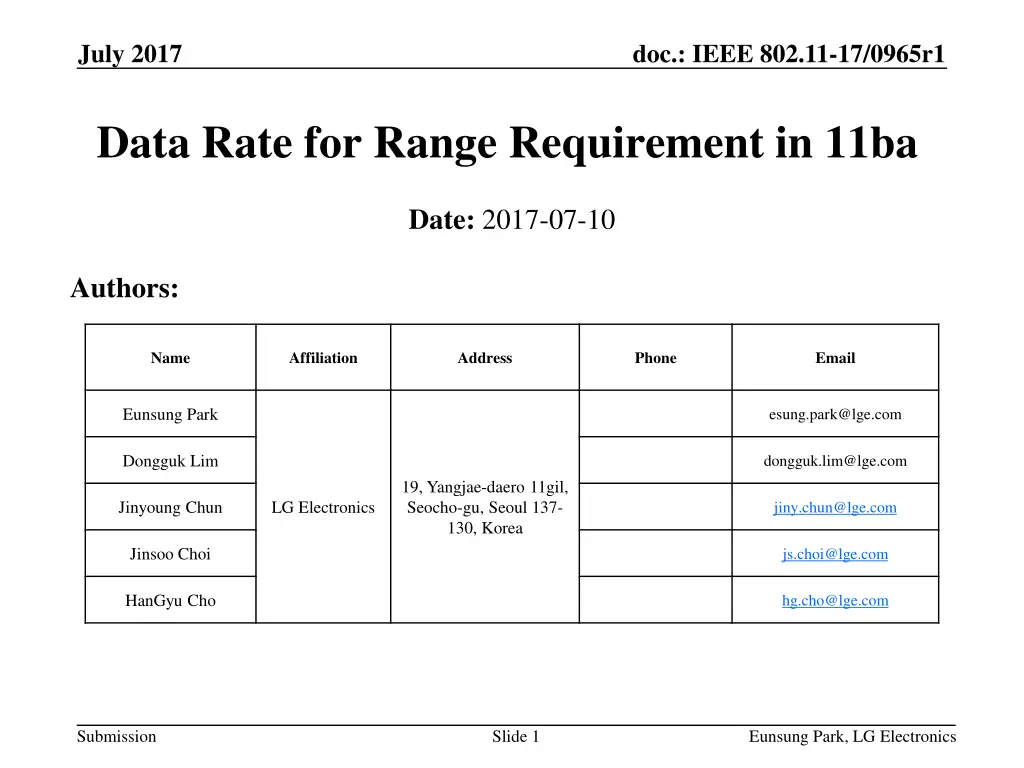
IEEE 802.11-17/0965r1 Data Rate for Range Requirement in 11ba
Explore the investigation on data rates for wake-up packet payload in 11ba from a range requirement perspective. Learn about target SNR definition, main radio performance considerations, simulation assumptions, and more to confirm required data rates for 11ba.
Download Presentation

Please find below an Image/Link to download the presentation.
The content on the website is provided AS IS for your information and personal use only. It may not be sold, licensed, or shared on other websites without obtaining consent from the author. If you encounter any issues during the download, it is possible that the publisher has removed the file from their server.
You are allowed to download the files provided on this website for personal or commercial use, subject to the condition that they are used lawfully. All files are the property of their respective owners.
The content on the website is provided AS IS for your information and personal use only. It may not be sold, licensed, or shared on other websites without obtaining consent from the author.
E N D
Presentation Transcript
July 2017 doc.: IEEE 802.11-17/0965r1 Data Rate for Range Requirement in 11ba Date: 2017-07-10 Authors: Name Affiliation Address Phone Email Eunsung Park esung.park@lge.com Dongguk Lim dongguk.lim@lge.com 19, Yangjae-daero 11gil, Seocho-gu, Seoul 137- 130, Korea Jinyoung Chun LG Electronics jiny.chun@lge.com Jinsoo Choi js.choi@lge.com HanGyu Cho hg.cho@lge.com Submission Slide 1 Eunsung Park, LG Electronics
July 2017 doc.: IEEE 802.11-17/0965r1 Introduction We already agreed to use multiple data rates for the payload part of wake-up packet In [1], we discussed the necessity of multiple data rates In this contribution, we investigate possible data rates for the payload part of wake-up packet from a range requirement viewpoint of 11ba To this end, we first define a target SNR for 11ba by considering the performance of the main radio, the noise figure and the power regulation in 2.4GHz and 5GHz bands In this contribution, we consider two candidates for the main radio performance, L- SIG performance [2] and data part performance [3] Then, we examine the performance for various data rates in 11ba even considering the BCC Finally, we confirm data rates required for 11ba by comparing the performance with the target SNR Submission Slide 2 Eunsung Park, LG Electronics
July 2017 doc.: IEEE 802.11-17/0965r1 Target SNR for Range Requirement The target SNR for the range requirement in 11ba is equal to 12dB/15dB lower SNR than the minimum SNR required for a reliable operation of the main radio in 2.4GHz/5GHz, respectively [4] To achieve the range requirement, 11ba should guarantee at least 10% PER at the target SNR The minimum SNR required for the main radio and the target SNR for 11ba can be obtained as follows by considering the L-SIG performance (at 1%) and the data part performance (at 10%) of the main radio shown in Appendix Minimum SNR required for the main radio [dB] Target SNR for 11ba [dB] Candidate for the main radio performance 2.4GHz 5GHz 2.4GHz 5GHz TGnD channel 6.7 6.7 -5.3 -8.3 L-SIG performance UMi NLoS channel 9.6 9.6 -2.4 -5.4 TGnD channel 8.3 8.3 -3.7 -6.7 Data part performance UMi NLoS channel 10 10 -2 -5 Note that the required SNR for the data part is higher than that of the L-SIG, and thus the transmission range which guarantees a reliable operation of the data part is shorter than that of the L-SIG That means some STAs can decode the L-SIG reliably but cannot decode the data part in the main radio Hence, these STAs don t have to be awakened to receive data Thus, it seems that the transmission range of wake-up packet just satisfies that of the data part of the main radio Slide 3 Submission Eunsung Park, LG Electronics
July 2017 doc.: IEEE 802.11-17/0965r1 Simulation Assumptions 4MHz signal bandwidth (13 subcarriers) 48 symbols in payload Four data rates : 15.625Kbps/31.25Kbps/62.5Kbps/125Kbps with or without BCC CFO [3], Phase noise [4] applied No timing error Butterworth filter 2.5MHz cut off frequency, second order 20MHz sampling rate TGnD and UMi NLoS channels in 2.4GHz and 5GHz SNR defined in 20MHz Submission Slide 4 Eunsung Park, LG Electronics
July 2017 doc.: IEEE 802.11-17/0965r1 OOK Symbol 125Kbps 62.5Kbps Option 1 (Without BCC) : 8us OOK symbol with Manchester coding (4us ON + 4us OFF or vice versa) Option 2 (With BCC) : 4us normal OOK symbol + BCC w/ code rate Option 1 (Without BCC) : 16us OOK symbol with Manchester coding (4us ON + 4us OFF + 4us ON + 4us OFF or vice versa) Option 2 (With BCC) : 8us OOK symbol with Manchester coding (4us ON + 4us OFF or vice versa) + BCC w/ code rate 31.25Kbps Option 1 (Without BCC) : 32us OOK symbol with Manchester coding (4us ON + 4us OFF + 4us ON + 4us OFF + 4us ON + 4us OFF + 4us ON + 4us OFF or vice versa) Option 2 (With BCC) : 16us OOK symbol with Manchester coding (4us ON + 4us OFF + 4us ON + 4us OFF or vice versa) + BCC w/ code rate 15.625Kbps Option 1 (Without BCC) : 64us OOK symbol with Manchester coding (4us ON + 4us OFF + 4us ON + 4us OFF + 4us ON + 4us OFF + 4us ON + 4us OFF + 4us ON + 4us OFF + 4us ON + 4us OFF + 4us ON + 4us OFF + 4us ON + 4us OFF or vice versa) Option 2 (With BCC) : 16us OOK symbol with Manchester coding (4us ON + 4us OFF + 4us ON + 4us OFF + 4us ON + 4us OFF + 4us ON + 4us OFF or vice versa) + BCC w/ code rate Submission Slide 5 Eunsung Park, LG Electronics
July 2017 doc.: IEEE 802.11-17/0965r1 PER Performance for Various Data Rates 2.4GHz PER Performance for UMi NLoS channel in 2.4GHz PER Performance for TGnD channel in 2.4GHz 0 0 10 10 Option 1 for 15.625kbps Option 2 for 15.625kbps Option 1 for 31.25kbps Option 2 for 31.25kbps Option 1 for 62.5kbps Option 2 for 62.5kbps Option 1 for 125kbps Option 2 for 125kbps Option 1 for 15.625kbps Option 2 for 15.625kbps Option 1 for 31.25kbps Option 2 for 31.25kbps Option 1 for 62.5kbps Option 2 for 62.5kbps Option 1 for 125kbps Option 2 for 125kbps -1 -1 10 10 PER PER -2 -2 10 10 -3 -3 10 10 -10 -5 0 5 10 15 -10 -5 0 5 10 15 SNR [dB] SNR [dB] TGnD Channel UMi NLoS Channel Submission Slide 6 Eunsung Park, LG Electronics
July 2017 doc.: IEEE 802.11-17/0965r1 PER Performance for Various Data Rates 5GHz PER Performance for TGnD channel in 5GHz PER Performance for UMi NLoS channel in 5GHz 0 0 10 10 Option 1 for 15.625kbps Option 2 for 15.625kbps Option 1 for 31.25kbps Option 2 for 31.25kbps Option 1 for 62.5kbps Option 2 for 62.5kbps Option 1 for 125kbps Option 2 for 125kbps Option 1 for 15.625kbps Option 2 for 15.625kbps Option 1 for 31.25kbps Option 2 for 31.25kbps Option 1 for 62.5kbps Option 2 for 62.5kbps Option 1 for 125kbps Option 2 for 125kbps -1 -1 10 10 PER PER -2 -2 10 10 -3 -3 10 10 -10 -5 0 5 10 15 -10 -5 0 5 10 15 SNR [dB] SNR [dB] TGnD Channel UMi NLoS Channel Submission Slide 7 Eunsung Park, LG Electronics
July 2017 doc.: IEEE 802.11-17/0965r1 Required SNR at 10% PER The required SNR at 10% PER for all options are as follows Required SNR in TGnD [dB] Required SNR in UMi NLoS [dB] Data Rate [Kbps] Option 2.4GHz 5GHz 2.4GHz 5GHz Option 1 (w/o BCC) -6.6 -6.1 -6.8 -6.5 15.625 Option 2 (w/ BCC) -8.8 -8.3 -9.6 -9.2 Option 1 (w/o BCC) -5 -4.6 -5.2 -4.7 31.25 Option 2 (w/ BCC) -7.3 -6.8 -8.1 -7.6 Option 1 (w/o BCC) -3.2 -2.8 -3.3 -3 62.5 Option 2 (w/ BCC) -5.8 -5.4 -6.5 -6.1 Option 1 (w/o BCC) -1.4 -0.9 -1.5 -1.1 125 Option 2 (w/ BCC) -4 -3.5 -4.8 -4.4 Target SNR in UMi NLoS [dB] Target SNR in TGnD [dB] Candidate for the main radio performance 2.4GHz 5GHz 2.4GHz 5GHz L-SIG -5.3 -8.3 -2.4 -5.4 Data part -3.7 -6.7 -2 -5 Submission Slide 8 Eunsung Park, LG Electronics
July 2017 doc.: IEEE 802.11-17/0965r1 Discussion (1/2) The following data rates meet the target SNR TGnD UMi NLoS Option 2.4GHz 5GHz 2.4GHz 5GHz Option 1 (w/o BCC) 15.625Kbps, 31.25Kbps, 62.5Kbps Lower than 15.625Kbps 15.625Kbps 15.625Kbps L-SIG 15.625Kbps, 31.25Kbps, 62.5Kbps 15.625Kbps, 31.25Kbps, 62.5Kbps Option 2 (w/ BCC) 15.625Kbps all data rates Option 1 (w/o BCC) 15.625Kbps, 31.25Kbps, 62.5Kbps 15.625Kbps, 31.25Kbps Lower than 15.625Kbps 15.625Kbps Data part 15.625Kbps, 31.25Kbps, 62.5Kbps Option 2 (w/ BCC) 15.625Kbps, 31.25Kbps all data rates all data rates Submission Slide 9 Eunsung Park, LG Electronics
July 2017 doc.: IEEE 802.11-17/0965r1 Discussion (2/2) For overhead minimization, the following data rates with BCC can be selected in each case TGnD UMi NLoS 2.4GHz 5GHz 2.4GHz 5GHz L-SIG 62.5Kbps 15.625Kbps 125Kbps 62.5Kbps Data part 125Kbps 31.25Kbps 125Kbps 62.5Kbps If 11ba is not allowed to use BCC due to the power consumption issue, the following data rates can be selected in each case TGnD UMi NLoS 2.4GHz 5GHz 2.4GHz 5GHz Lower than 15.625Kbps L-SIG 15.625Kbps 62.5Kbps 15.625Kbps Lower than 15.625Kbps Data part 31.25Kbps 62.5Kbps 15.625Kbps Submission Slide 10 Eunsung Park, LG Electronics
July 2017 doc.: IEEE 802.11-17/0965r1 Conclusion In this contribution, we verified necessary data rates for the payload part of wake- up packet to guarantee the range requirement of 11ba Required data rates w/ BCC Required data rates w/o BCC Candidate for the main radio performance 2.4GHz 5GHz 2.4GHz 5GHz L-SIG 15.625Kbps 15.625Kbps < 15.625Kbps 62.5Kbps Data part 125Kbps < 15.625Kbps 31.25Kbps 31.25Kbps Those data rates are different according to the candidate for the main radio performance Note that the lowest data rate of the payload part of wake-up packet can be determined by the data part performance of the main radio given a reliable operation of the main radio They also depend on whether to use BCC or not BCC is recommended for overhead reduction but its power consumption should be further discussed The lowest data rate can be determined by the required data rate in the 5GHz band if 11ba operates at this band Submission Slide 11 Eunsung Park, LG Electronics
July 2017 doc.: IEEE 802.11-17/0965r1 Straw Poll #1 Do you agree to use binary convolution code (BCC) rate 1/2 as in the 802.11 spec for the payload part of wake-up packet? Y/N/A : 10/11/12 Submission Slide 12 Eunsung Park, LG Electronics
July 2017 doc.: IEEE 802.11-17/0965r1 Straw Poll #2 Which data rate do you agree to use as the lowest data rate for the payload part of wake-up packet? 15.625Kbps 31.25Kbps 62.5Kbps 125Kbps 15.625/31.25/62.5/125/A : 0/11/27/4/6 Submission Slide 13 Eunsung Park, LG Electronics
July 2017 doc.: IEEE 802.11-17/0965r1 Straw Poll #3 Do you agree to add the following to the 11ba SFD? The data rate of 31.25Kbps for the payload part of wake-up packet is computed by applying BCC with the code rate of to 16us OOK symbol with Manchester coding (i.e., 4us ON + 4us OFF + 4us ON + 4us OFF or vice versa) Y/N/A : Submission Slide 14 Eunsung Park, LG Electronics
July 2017 doc.: IEEE 802.11-17/0965r1 Straw Poll #4 Do you agree to add the following to the 11ba SFD? The data rate of 62.5Kbps for the payload part of wake-up packet is computed by applying BCC with the code rate of to 8us OOK symbol with Manchester coding (i.e., 4us ON + 4us OFF or vice versa) Y/N/A : Submission Slide 15 Eunsung Park, LG Electronics
July 2017 doc.: IEEE 802.11-17/0965r1 Motion Move to add the following to the 11ba SFD The lowest data rate for the payload part of wake-up packet is 62.5Kbps Move : Eunsung Park Second : Y/N/A : Submission Slide 16 Eunsung Park, LG Electronics
July 2017 doc.: IEEE 802.11-17/0965r1 References [1] IEEE 802.11-17/0654r3 Multiple Data Rates for WUR [2] IEEE 802.11-17/0655r4 OOK Signal Bandwidth for WUR [3] IEEE 802.11-17/0656r0 WUR PHY Performance Study with Phase Noise and ACI [4] IEEE 802.11-17/0365r0 Regulations and Noise Figure - Impact on SNR Submission Slide 17 Eunsung Park, LG Electronics
July 2017 doc.: IEEE 802.11-17/0965r1 Appendix Submission Slide 18 Eunsung Park, LG Electronics
July 2017 doc.: IEEE 802.11-17/0965r1 PER Performance for Main Radio Data part : 100bytes with MCS0 PER Performance for Main Radio in UMi NLoS channel PER Performance for Main Radio in TGnD channel 0 0 10 10 LSIG in 2.4GHz LSIG in 5GHz 100bytes Data in 2.4GHz 100bytes Data in 5GHz LSIG in 2.4GHz LSIG in 5GHz 100bytes Data in 2.4GHz 100bytes Data in 5GHz -1 -1 10 10 PER PER -2 -2 10 10 -3 -3 10 10 -5 0 5 10 15 20 -5 0 5 10 15 20 SNR [dB] SNR [dB] TGnD Channel UMi NLoS Channel Submission Slide 19 Eunsung Park, LG Electronics


